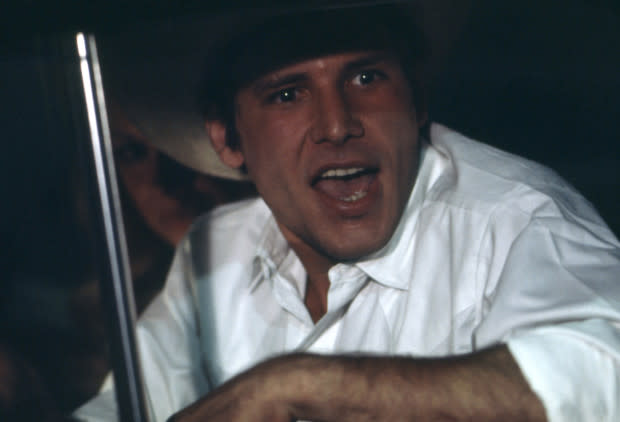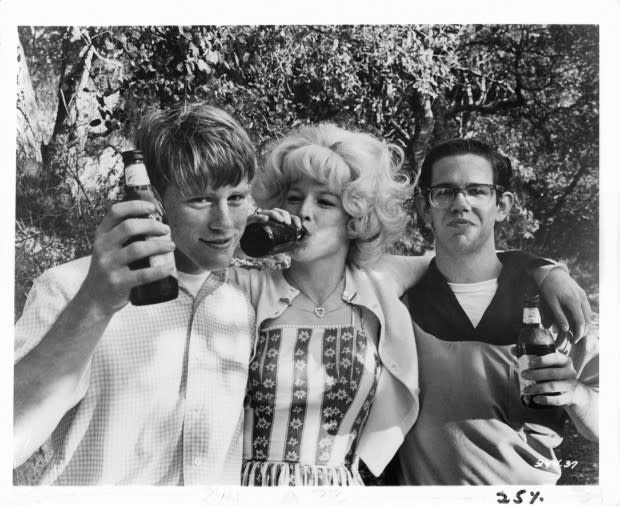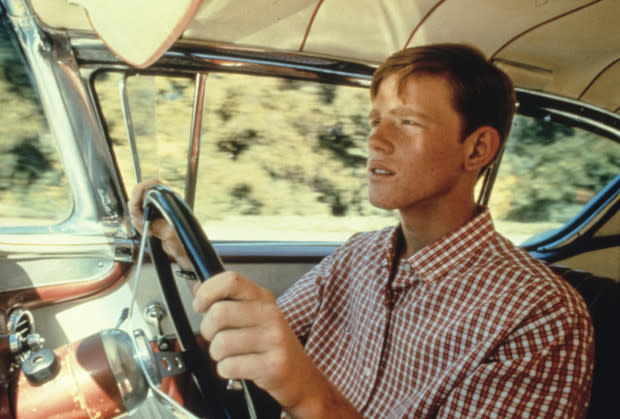30 Things You Didn't Know About 'American Graffiti'

American Graffiti is turning 50!
Debuting in a single theater in Los Angeles on Aug. 12, 1973, it quickly mushroomed into a massive, crowd-pleasing pop-cultural phenomenon. A hit in theaters everywhere, it was later recognized as one of Hollywood’s first “tentpole” movies, a film so over-the-top successful at the box office that it could support, and mitigate, a studio’s lesser-profitable releases. It’s now regarded and revered as a rule-breaking cinematic triumph, a potent launching pad for several Hollywood careers and a timeless coming-of-age, California car-culture classic. The American Film Institute lists it on its registry of the 100 greatest films of all time, and it’s preserved in the National Film Registry and the Library of Congress.
While American Graffiti has received plenty of attention over the years, here are 30 things about the beloved film that you might not know.
1. When Terry the “Toad” (Charles Martin Smith) loses control of his scooter and crashes into a trash can at Mel’s Diner, that wasn’t in the script. Smith really did have trouble putting on the brakes, and director George Lucas decided to keep the gaffe in the film.
2. The water balloon thrown at Carol (Mackenzie Phillips) when she’s riding around with John (Paul LeMat) was supposed to burst on the car frame. But it missed and spattered directly on Phillips’ face—and her surprised laughter in the scene was real.

Getty Images
3. Fledging actor Harrison Ford was offered $485 a week for his role as street racer Bob Falfa but turned it down—because he could make more at his “real” job as a Hollywood carpenter. He relented when the amount was raised to $500.
4. The budget was so tight, there was little money to lease or rent the armada of vintage ‘50s vehicles needed for the film. Owners of the cars who offered up their ‘rods were paid $20 to $25 and given free movie food.
5. Producers wanted Harrison Ford to cut his hair into a flattop for his brief role, but he refused. The compromise: He cruises in a cowboy hat, a white Stetson. “I was afraid if something else came up, some other acting job, I might not be able to do it because of the crew cut,” he has said.
6. In a movie about high school students, only two of the actors (Ron Howard and Charles Martin Smith, both 18) were really teens. The other main cast members were older, most in their 20s, with the exceptions of 12-year-old Mackenzie Phillips and Harrison Ford, who turned 30 during filming.
7. During editing and matching up of film with dialogue, someone asked director George Lucas for “reel two, dialogue two.” A couple of years later, when Lucas was making Star Wars, he gave one of the droids the classic name of R2D2. Hmmm, wonder where he got that idea?
Related: These Are the 60 Best High School Movies of All Time

Getty Images
8. Studio execs were skeptical of the film’s title; they didn’t know what “American Graffiti” meant. They suggested many alternates, including Rock Around the Block, The Drag Years, Summer Blood and Another Slow Night in Modesto—none of which worked for director George Lucas, who’d written the screenplay (with Willard Huyck and Gloria Katz), and producer Frances Ford Coppola.
9. After the movie was finished, Universal Studios wasn’t terribly impressed; they wanted to re-edit it and possibly turn it into TV movie. But they decided to leave it alone after producer Frances Ford Coppola—who had just directed The Godfather, which was already on the way to being a smash—gave them an ultimatum: He was prepared to purchase the film himself to release theatrically if the studio tried to take it away and squish it into the small screen.
10. A movie poster for American Graffiti, depicting all the charters in an exaggerated, cartoon-y montage, was drawn by Mort Drucker, an illustrator for Mad magazine. The artwork is now an exhibit in The Library of Congress.
11. The filmmakers were so impressed with Richard Dreyfuss and his abilities, they gave him a choice between playing two characters: the high school “leading man,” Steve, who ultimately gets his girl, or the loner Curt, who spends the night searching for a mysterious blonde. He chose Curt.
12. The film was shot almost entirely at night, between the 9 p.m. and sunrise, with many off-camera cast members and crew huddled in blankets to ward off the California chill or sleeping in unused vehicles. “It was cold most nights,” Howard recalls. “And we [some characters] were wearing T-shirts.”
13. When DJ Wolfman Jack prank calls a pizza worker, the voice of the employee—unseen on the other end of the phone—is that of George Lucas.
14. American Graffiti was one of the first major movies to use actual pop hits instead of original scored music for a soundtrack, a technique later embraced by Martin Scorsese in Goodfellas and Quentin Tarantino in most of his films.
15. Paul Le Mat’s Brando-esque street racing character was such a hit with fans, a similar character was added to a later retro-nostalgic TV show: Fonzie on Happy Days.
16. Johnny Weismuller Jr., whose dad famously portrayed Tarzan in a dozen films during the 1930s and 1940s, has a small role as one of two street toughs (credited as “Badass No. 1”) who briefly menace Terry the Toad.

Universal Pictures
17. You probably know that Ron Howard went on to become an entertainment mogul, an Oscar-winning director and a TV and film producer. But did you know he also came up with concept for the TV cult hit Arrested Development? He produced the show, narrated it and made several appearances during the comedy series’ 2003-2006 run as a fictionalized version of himself.
18. The mysterious, elusive blonde (Suzanne Somers) who bewitches Curt (Richard Dreyfuss) from her Ford Thunderbird was originally intended to be a figment of Curt’s imagination. A sequence explaining the fantasy element was never filmed, due to the movie’s tight budget.
19. The plaid shirt worn by Richard Dreyfuss’ character was deemed by cinematographer Haskell Wexler to be perfect for setting and adjusting the cameras before each take. So Dreyfuss became a human “test pattern,” standing in front of the lens for almost every scene. “I hated that shirt,” Dreyfuss recalls.
20. Director George Lucas—who worked for a while as a foreign car mechanic—initially envisioned the movie as an ode to America’s car culture, one in which he had enthusiastically participated. “Like most kids who grew up in the [San Fernando] Valley, I did a lot of cruising,” he said in a 1998 making-of documentary. “I really felt compelled to document this uniquely American mating ritual using automobiles.”
21. Hundreds of young actors auditioned, and most didn’t get a part. One of them, Mark Hamill, however, was cast in director Lucas’ next movie, a fanciful little space-fi project called Stars Wars, in the role of Luke Skywalker.
22. Producer Frances Ford Coppola, himself a filmmaker at the time (he’d just finished directing The Godfather!), gets an insider “Easter egg” nod in a shot of a movie theater showing Dementia 13, the title of his first film. Director George Lucas gets a similar shout-out with a license plate reading THX 138, his debut film.
23. As a prank, his fellow cast members threw Richard Dreyfuss into the pool at their Holiday Inn, where he hit his face on the bottom, leaving him with a bright shiner that had to be concealed the next day with makeup provided by costar Cindy Williams.
24. The DC-7 airplane boarded by Curt (Richard Dreyfuss) at the end of the film was once leased to rock group Grand Funk Railroad. Made in 1956 and used for a variety of services over three decades, it crashed on its final flight in 1986, killing three crew members.

Getty Images
25. Did Ron Howard’s role in American Graffiti lead to his TV stardom in Happy Days, which debuted on ABC two years later? Sort of. The fact that Howard’s Graffiti character seems a lot like Richie Cunningham, whom he’d later play in Happy Days, is likely because the movie producers saw him in the Happy Days pilot, which was already “in the can” but waiting for a TV greenlight. After the success of American Graffiti, Happy Days was rushed into production as a full-fledged series.
26. Choreography for the big gymnasium dance scene was coordinated by Toni Basil, who would go on in the 1980s to score a Top 40 pop hit with “Mickey.”
27. Some two decades after the film was released, a group of teenage high school girls in Petaluma, Calif., spearheaded a movement to get a movie theater in the town where the movie was primarily filmed. The turning point for their crusade came when Lucas’ production company provided a copy of American Graffiti for them to screen at an awareness rally, ultimately leading to the construction of a $9 million multiplex.
28. The success of American Graffiti opened doors to Hollywood’s future with other movies that also banked on America’s appetite for nostalgia and coming-of-age tales, like Animal House, The Lords of Flatbush, Stand by Me, Grease, Dazed and Confused and Almost Famous.
29. Mel’s Drive-In, an actual eatery in San Francisco, was used as the hub for some of the movie’s activities. It was later demolished but became a local franchise after the film became a hit, leading to the opening of several Mel’s in Southern California.
30. The 1979 sequel, More American Graffiti, featured all the main cast from the original movie, except Richard Dreyfuss. Ron Howard reprised his role as Steve, making his final appearance as a “credited character” in a theatrical film before moving fully into directing. Even though several cast members (Cindy Williams, Harrison Ford and Howard) had gone on to become certifiably bigger stars in 1979—due to their subsequent appearances in Laverne & Shirley, Happy Days and Star Wars—the sequel’s box-office success paled in comparison and movie critics mostly panned it.
